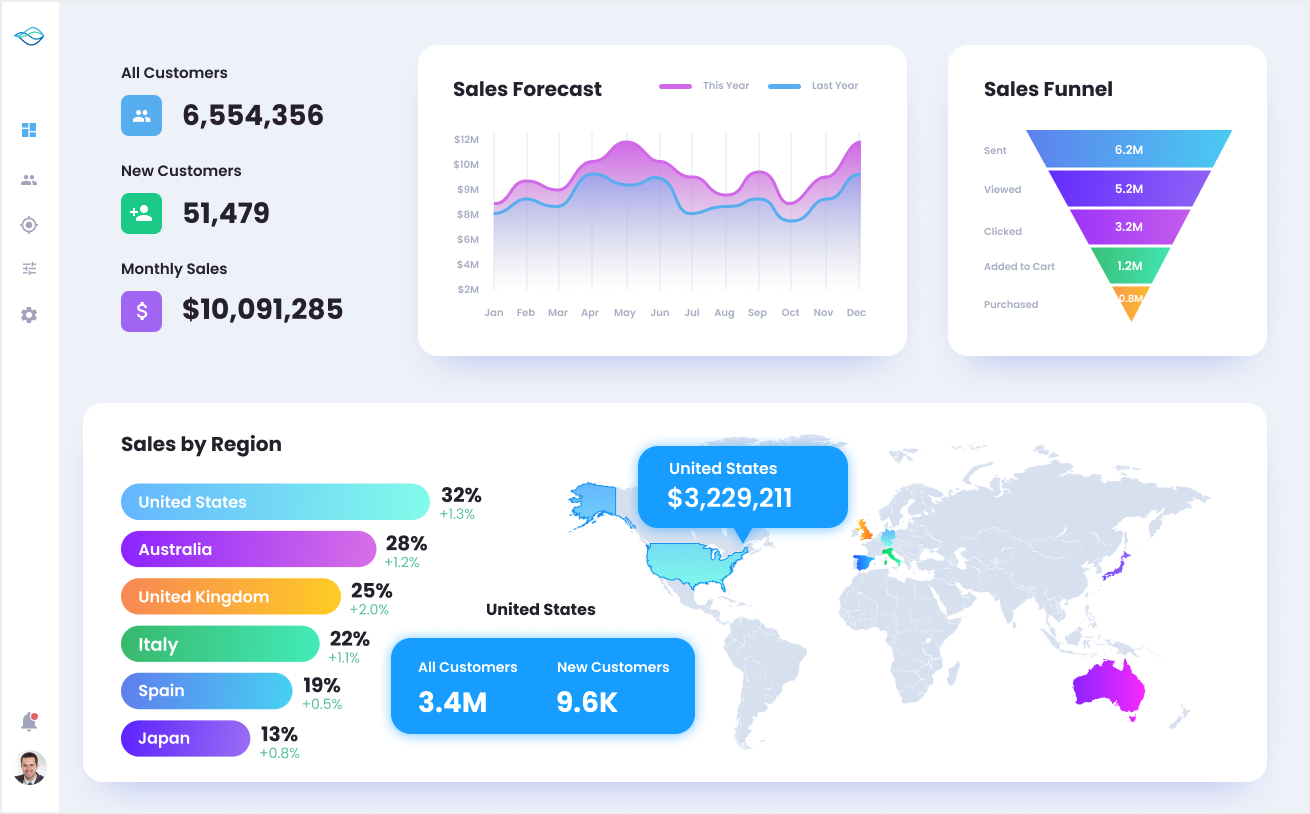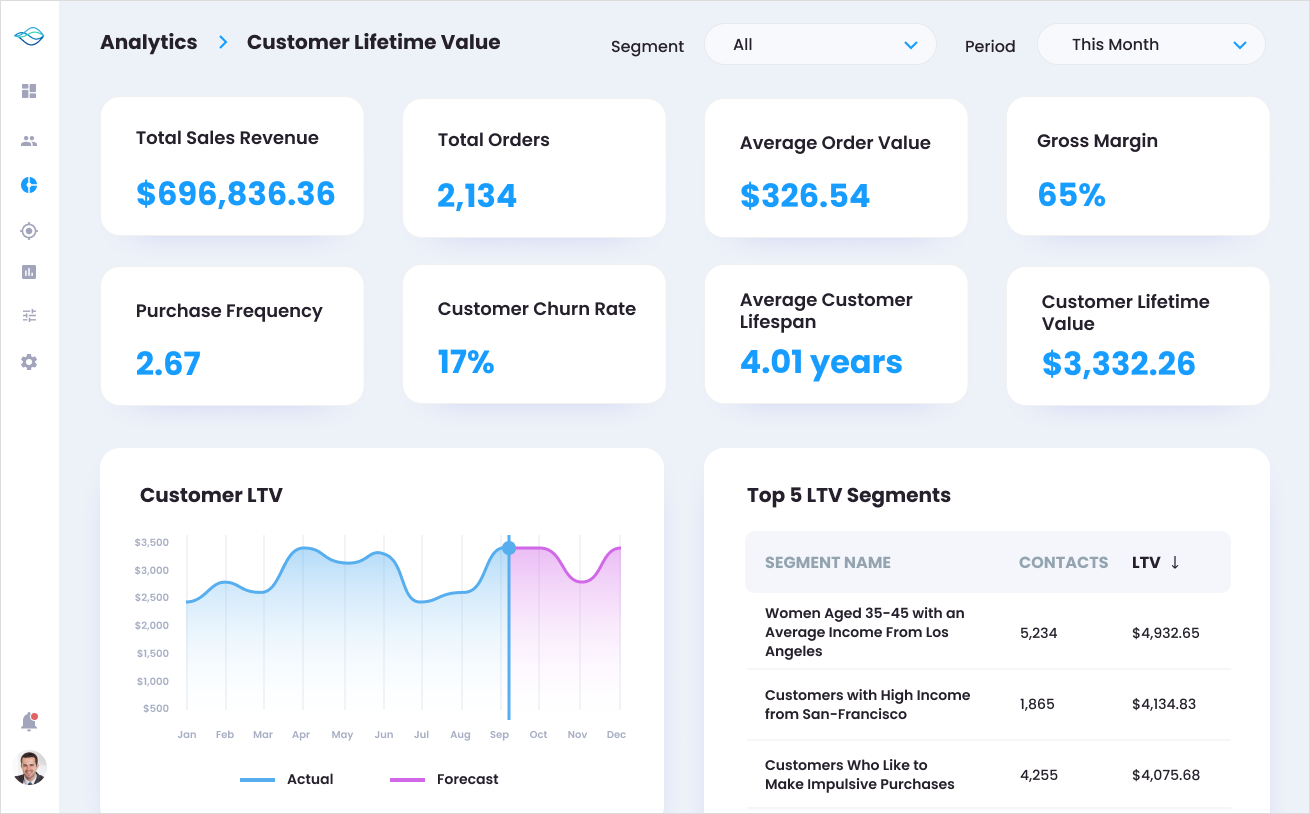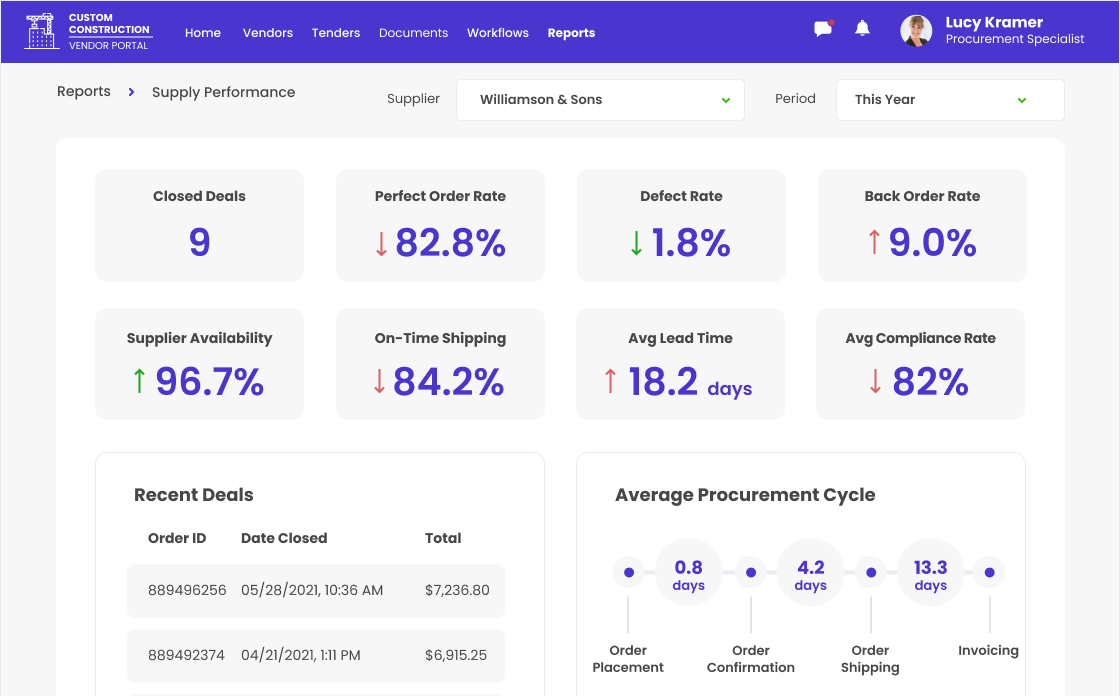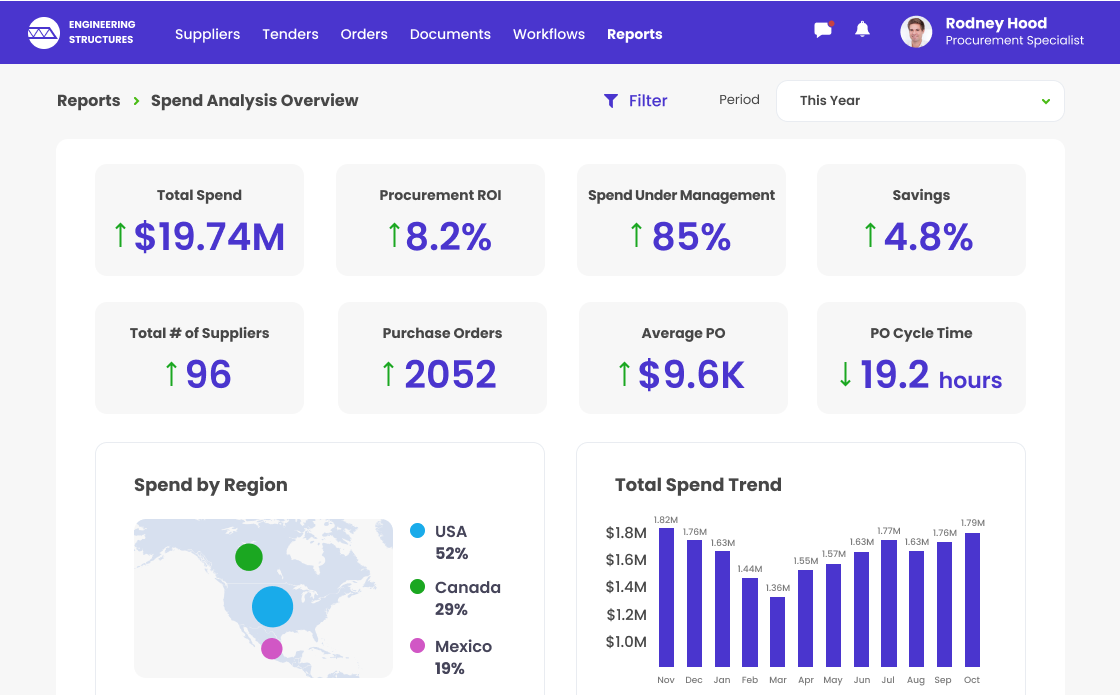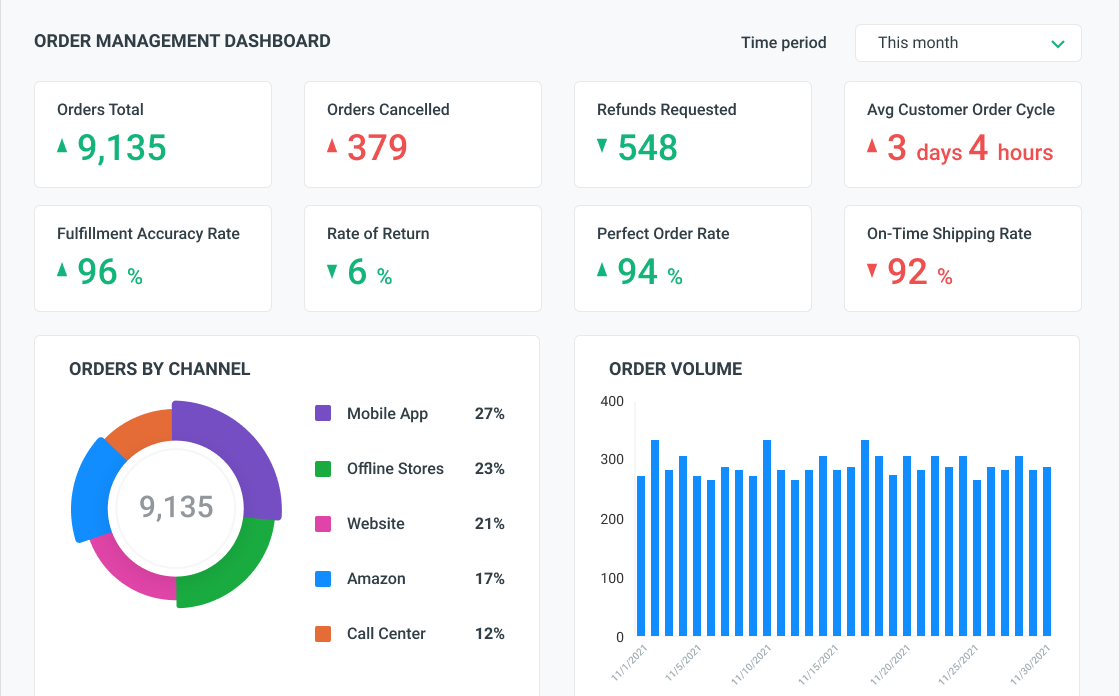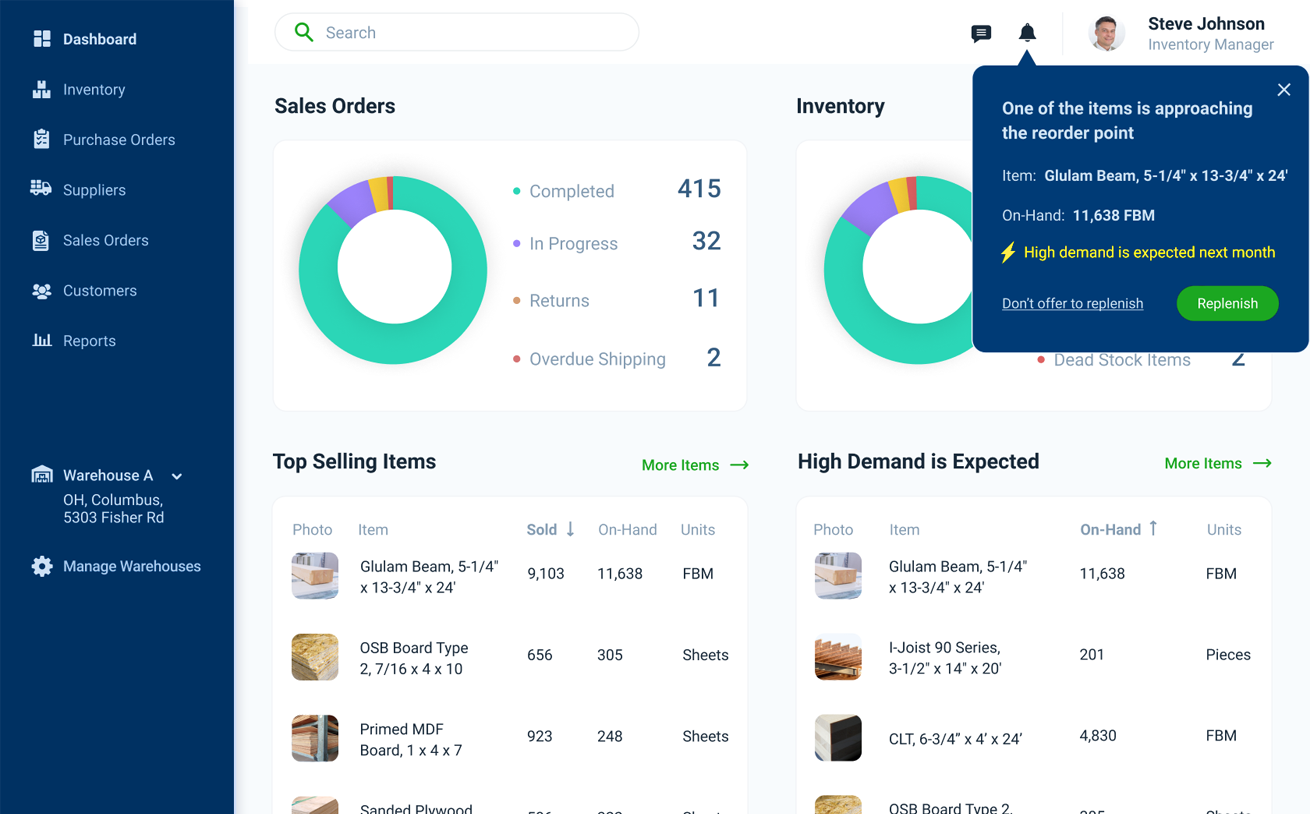Retail Data Analytics
A Full Overview
ScienceSoft applies 35 years of experience in data analytics and 21 years in retail IT to help retail businesses build smart data analytics solutions that increase sales and drive significant cost-saving opportunities.
Retail Data Analytics: The Essence
Retail analytics is needed to collect, process, and analyze valuable data from every facet of a retail business. Retail analytics solutions include customer, sales, and supply chain analytics; inventory and price optimization; merchandising and marketing analytics for brick-and-mortar and ecommerce stores. Advanced analytics solutions powered by AI and ML provide intelligent insights for real-time decision-making (e.g., personalized product recommendations for online customers) as well as for long-term planning and forecasting that help drive stable business growth.
- Integrations: CRM, customer service management software, inventory management software, marketing campaign management software, supplier management software, POS software, an ecommerce platform.
- Users: managers, and specialists in sales, marketing, customer support, inventory, ecommerce, and merchandising, financial analysts.
- Implementation costs: $80,000–$1,000,000, depending on a solution’s complexity. You are welcome to use our online calculator to get a tailored ballpark estimate for your project.
- Implementation results: up to 60% increase in the operating margin.
Retail Analytics Solution: Key Features
At ScienceSoft, we develop retail business analytics solutions that match the unique needs of each of our clients. Below, our consultants list the features that are most frequently demanded by our clients in retail industry.
Essential Integrations for a Retail Analytics Solution
ScienceSoft recommends establishing the following integrations in order to get a 360-degree customer view and comprehensive insight into retail business performance:

- To enable customer segmentation.
- To calculate customer-related metrics: engagement, satisfaction, profitability rates.
- To analyze service requests by issue type, location, customer demographics, etc.
- To identify flaws in customer service, inventory management, delivery, and other processes affecting customer satisfaction and get suggestions on the optimal ways to fix them.
Point of sale (POS) system
- To identify customer spending habits like the buying time or preferred payment method.
- To analyze sales performance per store/season/geographical location, etc.
- To analyze customer online behavior and optimize marketing, cross-selling, and other activities based on the acquired insights.
- To offer personalized suggestions to each customer based on their preferences.
SCM & inventory management software
- To minimize inventory-related costs and optimize stock levels.
- To analyze supplier performance and choose the most efficient and reliable suppliers, determine the top-performing products by supplier.
- To provide a consolidated view of the retail business performance, including sales, inventory, marketing, etc.
- To assess marketing campaign performance and get intelligent insights for marketing optimization (identifying the most profitable markdown strategies, forecasting the efficiency of targeted promotional activities, etc.).
- To suggest personalized marketing campaigns at different levels of granularity (by a customer’s product preferences, type of device, income level, location, etc.).
An in-store computer vision system
- To quickly identify and react to situations like empty shelves or long checkout queues.
- To analyze customer routes and actions and optimize merchandising and store navigation.
- To detect possible security gaps (e.g., fraud at self-checkout stations) and timely take preventive measures.
Factors That Drive High ROI of Retail Data Analytics
With 35 years of experience in data analytics and 21 years in implementing retail IT solutions, ScienceSoft has defined the key factors determining the success of retail analytics software.
Scalability
To make sure the solution will be able to handle the growing volumes of data and new data sources as your business expands.
Focus on security
To protect sensitive customer, business, and financial data against cyberattacks or unauthorized modification by implementing robust security mechanisms for data backup, encryption, authentication, sharing, etc.
AI-based analytics
To enable advanced analytics capabilities, such as intelligent demand forecasting, real-time personalized suggestions for online customers, dynamic pricing optimization, etc.
Retail Data Analytics Success Stories by ScienceSoft
14 results for:

The World's Largest PLM Software With a Complex Analytics Module
The analytics module consolidates data from 20 globally distributed databases. Being part of the PLM solution, it helps 12,000 manufacturers and 32 large retailers worldwide communicate faster and improve supply chain transparency.

Big Data Solution for a 360-Degree Customer View and Optimized Stock Management
ScienceSoft delivered a centralized data analytics solution that allowed a multibusiness corporation to get a 360-degree customer view, optimize stock management, and assess the employees’ performance.

Data Analytics Solution for Sales Analysis across 10,500 Stores
A BI tool for a multinational FMCG corporation with more than 200 markets, 1 billion consumers and 60,000 employees worldwide. The solution helped the Customer distribute 100 SKUs across 10 retail chains and 10,500 stores.

Data Analytics Solution For E-Collaborative Product Life Cycle Management
An analysis and reporting module of product life cycle management system for 18,500+ manufacturers and retailers allows precise control over tendering, launching and development of consumer goods. The key advantage of the system is assuring the standard-driven safety of food and non-food products.

Scalable BI Solution and Customizable Reports for a Food Manufacturer and Distributor
ScienceSoft designed and developed a robust BI solution for a large US-based food manufacturer and distributor. The BI platform delivered in six months helps the Customer efficiently consolidate and analyze business data from multiple sources for improved enterprise decision-making.
What makes ScienceSoft different
We achieve project success no matter what
ScienceSoft does not pass mere project administration off as project management, a practice that's unfortunately common in the market. We drive projects to their goals, mitigating risks and overcoming constraints.
Costs and Benefits of Implementing Retail Analytics
The cost of implementing a retail data analytics solution may vary from $80,000 to $1,000,000*, depending on the software complexity, the diversity of integrations, and the number of user roles.
$80,000–$200,000
A basic solution that encompasses 1–2 business areas (e.g., sales and finance) and enables scheduled processing of structured data like sales results and customer demographics; ensures rule-based analytics, e.g., threshold-dependent product reordering.
$200,000–$400,000
A solution of medium complexity that encompasses multiple business areas (e.g., customers, SCM, finance) and enables both scheduled and real-time data processing (including unstructured data like customer service transcripts and social media content); ensures rule-based and ML/AI-powered analytics.
$400,000–$1,000,000
An advanced solution that encompasses multiple business areas and geographic divisions and has analytics features powered by big data and complex ML/AI techs, e.g., instant personalized recommendations to customers, dynamic pricing optimization.
*Software license fees are not included.
The implementation of business analytics in retail brings:
Tools We Use to Facilitate ML-Powered Retail Data Analytics
Although ML is not an obligatory element of the solutions we build, it has been in demand recently. So, we’ve decided to share an overview of two tools that can help enable such functionality quickly and cost-effectively. Both tools provide a wide range of features to build, train, and deploy ML models with a high degree of automation and no-code capabilities.

AWS SageMaker
Features
- 150+ pre-trained ML models.
- Complete security of ML artifacts due to data encryption in transit and at rest and the user’s full ownership over the ML-produced content.
- Native integration with Amazon services: Amazon S3, Amazon Redshift, AWS Glue, Amazon EMR, or AWS Lake Formation.
- Support for real-time, batch, and asynchronous deployment of ML models.
Caution
Although SageMaker provides zero-code capabilities for building and deploying ML models, it can still be too complex for data analysts with a limited programming background.
Pricing
Free tier usage: available for the first 6 months.
On-demand pricing: $0.05–$28.152/hour.
Costs optimization: savings plans can reduce costs by up to 64%.
Azure Machine Learning
Features
- Supports training and deploying ML models both on-premises and in the cloud.
- Adoptable scaling of ML learning models with Azure compute for accelerated training.
- Registries for sharing and finding ML artifacts across different teams.
- Native integration with other Microsoft services: Azure Synapse, Azure Storage Blobs, Azure App Service, and more.
- Continuous monitoring of ML models with Azure Security Center.
- Automated usage cost control with quota limits and automatic shutdown.
Caution
The variety of ML models that can be created with this tool is limited and can fail to meet a retailer’s needs.
Pricing
Free start option with a $200 credit for 30 days.
On-demand pricing: $0.096–$22.032/hour.
Costs optimization: savings plans for reserved instances can reduce costs by up to 73%.
Consider ScienceSoft’s Services to Implement Your Retail Data Analytics Solution
Delivering complex retail solutions since 2003, ScienceSoft offers data analytics consulting and implementation services to help retail businesses quickly respond to market changes and stay ahead of their competitors.
About ScienceSoft
ScienceSoft is an IT consulting and software development company headquartered in McKinney, Texas. Since 2003, we help midsize and large retail companies leverage advanced data analytics to drive their business growth. Achieving project goals in spite of time and budget constraints, as well as changing requirements, is ScienceSoft's top priority. You set goals, we drive the project to fulfill them.
